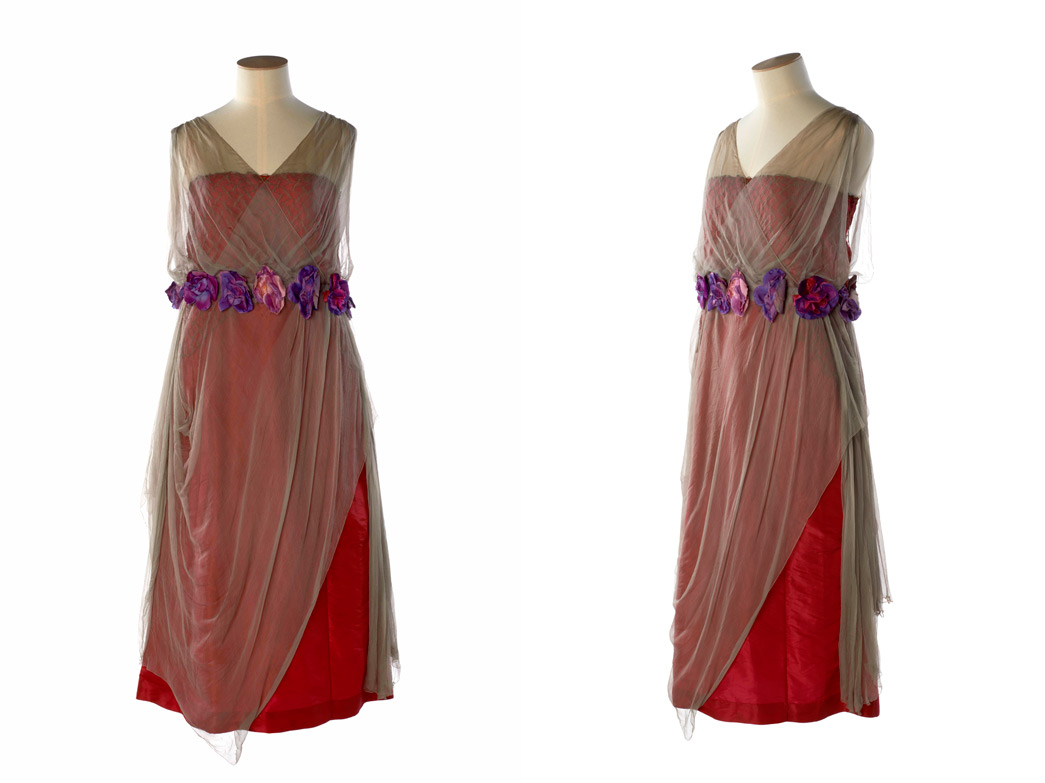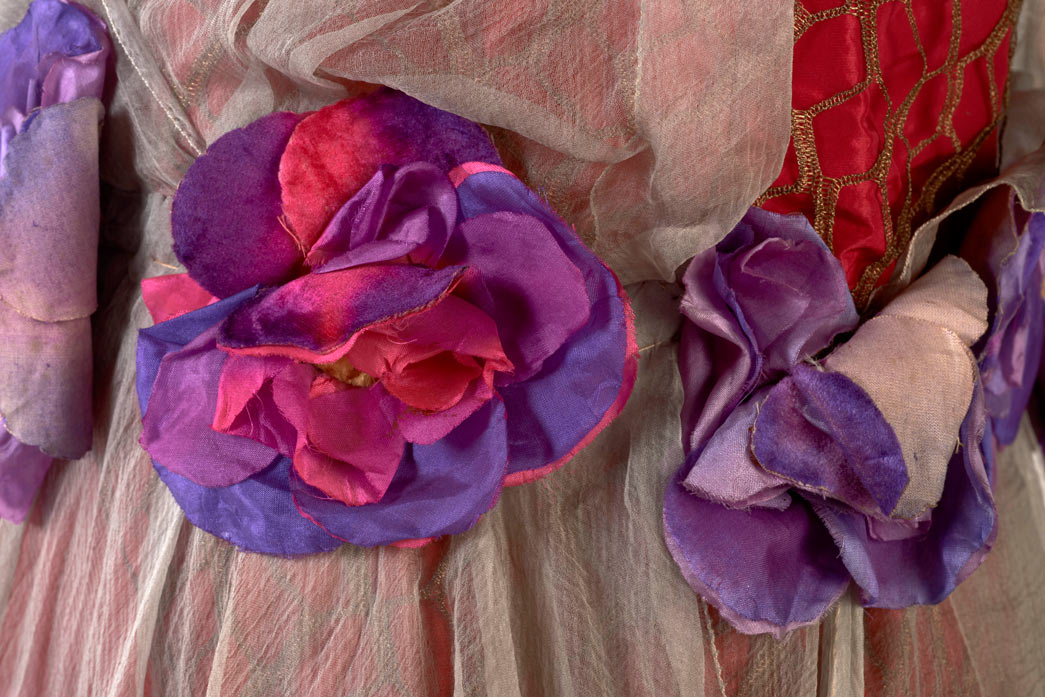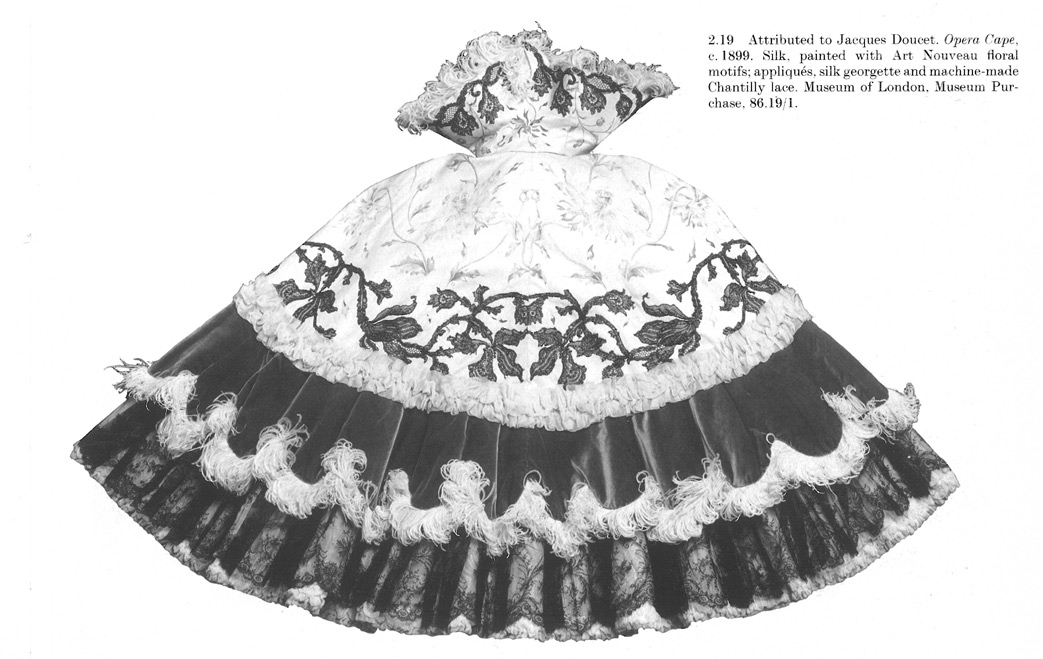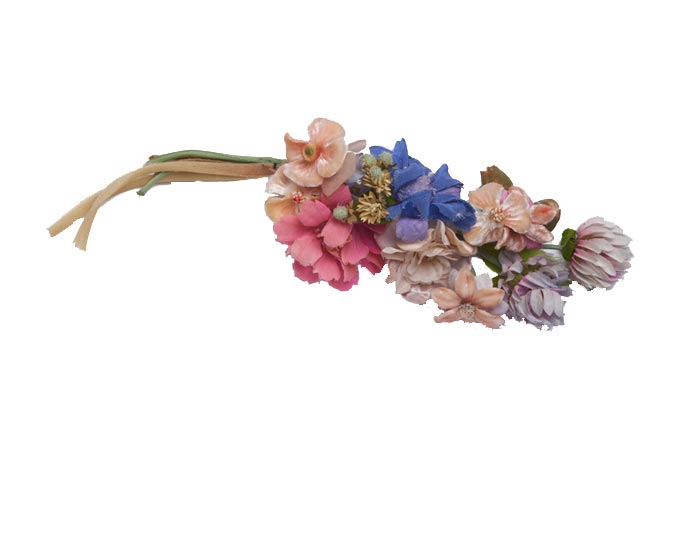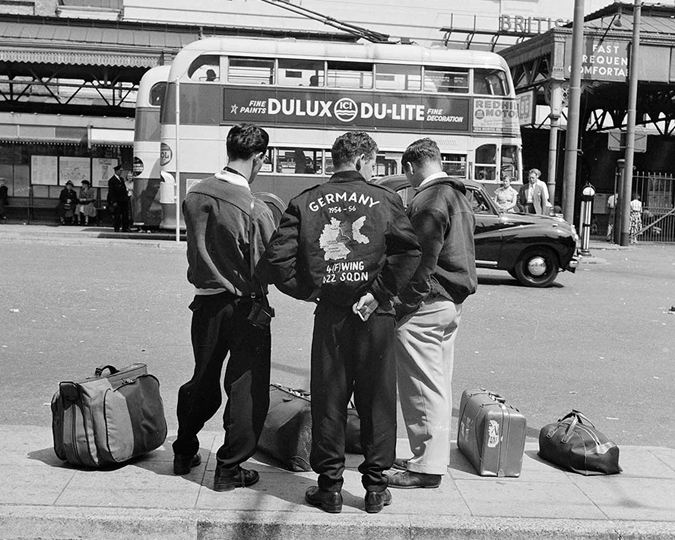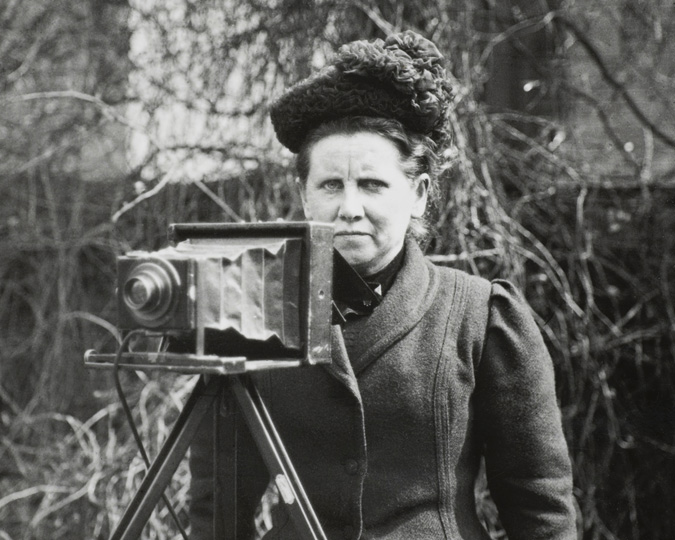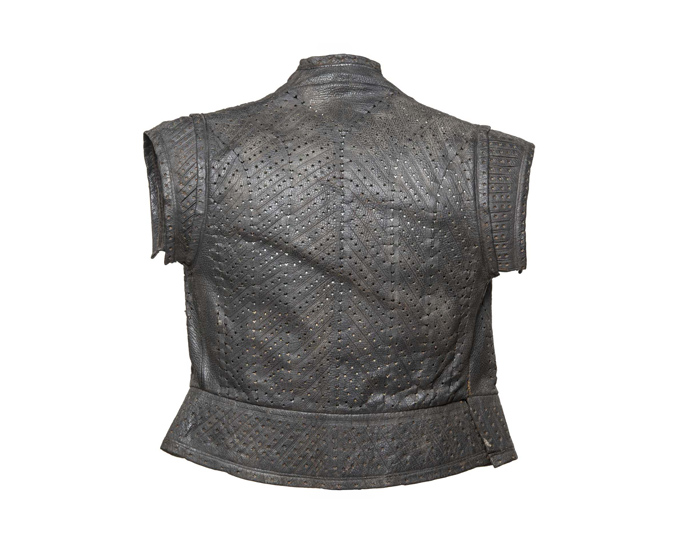Some very interesting people have worked for the Museum of London in the past (hopefully some of us are still interesting). I have always been particularly fond of Guy Laking, the first keeper of the London Museum; the wonderfully named Thalassa Cruso, assistant keeper of the costume collection in the 1930s and later gardening TV presenter, and of course, Mortimer Wheeler, Keeper of the London Museum from 1926 to 1933, here in action in 1956 on the TV game show Animal, Vegetable, Mineral?
I was delighted to meet another intriguing former staff member, when recently preparing a display on artificial flower making for our Show Space area. We were looking for a larger object decorated with flowers that would go well with the hats and bonnets we had selected, and came across a brightly coloured dress from the time of the First World War. Like the real thing, artificial flowers are rather delicate and the ones attached to the waistline of the dress had suffered somewhat. But the former splendour of the gown and its decoration was still discernible and furthermore, it was destined for Show Space, our ‘experimental’ temporary display area. Show Space lets us sometimes display items that are not necessarily in pristine condition, but are nevertheless worth showing off.
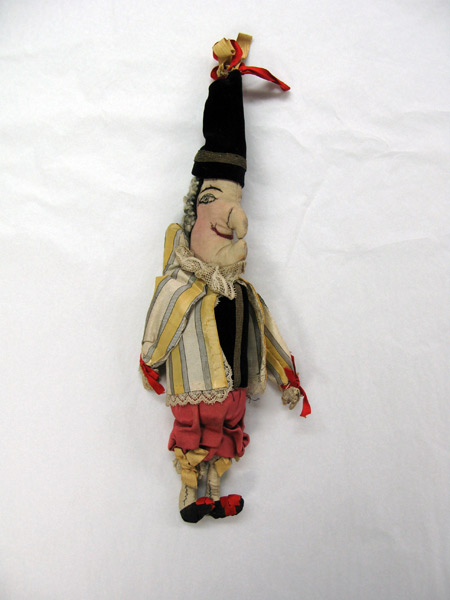
Punch rag doll
Early 20th century; ID no. 86.19/6.
I could see from our database that the dress had originally been lent to the museum in 1940 by a ‘Countess de Cardi’, together with another gown, a cape, two parasols and a Punch rag doll. In 1986 we acquired these objects permanently from the Countess’ daughter, Beatrice de Cardi. If you interested in archaeology, you will likely have heard of my namesake, who celebrated her 100th birthday two years ago. You will find a lot of information about Beatrice de Cardi’s impressive achievements elsewhere, so I will try to keep this short.
Beatrice de Cardi was born on 5 June 1914, the second daughter of Edwin de Cardi (1875-1935), whose family originated in Corsica, and his American wife Christine Berbette Wurfflein (1875-1964). In 2012 the museum recorded an oral history interview with Beatrice de Cardi. In her own words, her parents were ‘farsighted about education’. De Cardi went to St Paul’s Girls School before studying History, Economic History and Economics at University College, London. There she attended lectures on Roman Britain by Mortimer Wheeler, then Keeper at the London Museum. Her childhood interest in archaeology rekindled, in 1936 de Cardi became Wheeler’s secretary at the London Museum. When his assistant, the already mentioned Thalassa Cruso, left, Beatrice took over her post. She stayed at the museum until 1944.
In 1944, Beatrice was offered a job in the War Cabinet in China and ‘lent’ by the Museum to the Foreign Office. In April 1944 she flew out to India from where she travelled to China over ‘The Hump’ - the Himalayas – several times by plane, a treacherous journey at that period. Finding out that her London Museum job had been filled, Beatrice remained with the Foreign Office after the war, briefly in India and, after Partition, in Pakistan. From there she started to make forays into Qatar to research prehistoric pottery. If I tried to do justice to her subsequent, extraordinary career, I'd only botch it. Have a look at the short biography on the British Museum’s website, or watch this video to listen to Beatrice de Cardi herself.
It seems frivolous to get back to frocks after this, but clothes are serious business, and I feel vindicated by something that Beatrice de Cardi mentions in her interview. The objects in our collection date from the time of Beatrice’s birth or even before, so I knew they had to belong to her mother. During the First World War, the de Cardi family lived in an apartment in Maida Vale and, despite her very young age, Beatrice still remembered one particular incident, in which a dress played a role:
I have only one recollection of World War One, but that is an unusual one. I must have been no more than 2 ½ or 3 at the time when zeppelins were over London and the family moved down to its coal cellar. I can remember my mother clad in an evening dress of black velvet trimmed with sable clutching me and we stood until a chair was brought and I wondered was on earth she was doing in that sort of dress and surrounded by coal. I think it was a dress that I remember on its tactile interest and certainly it’s an element in my character that has survived because I have always had an interest in clothes and their feeling.
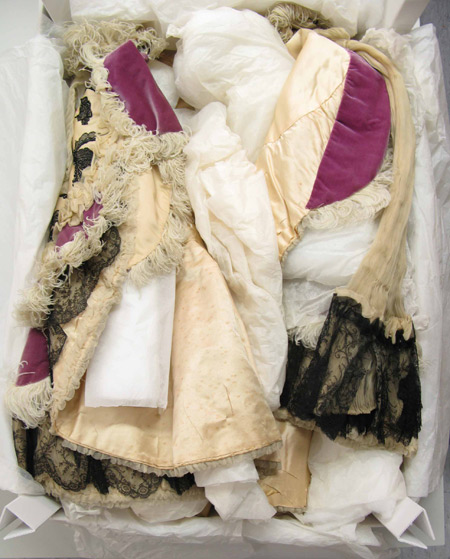
Opera cloak
Satin, velvet, lace, ostrich feather. Jacques Doucet, early 20th century. ID no. 86.19/1.
Beatrice’s mother had exquisite taste. Her loan included a satin, velvet, lace and ostrich feather cloak said to have been made by the French couturier Jacques Doucet in the early 20th century. It is very fragile now, and I can only photograph it in its storage box. When we have time to repack it, we must photograph the back of the cloak, which is hand painted (!). My thanks to my fellow curator Tim Long for letting me know about the photograph of our cloak published in The Opulent Era: Fashions of Worth, Doucet and Pingat by Elizabeth Ann Coleman in 1990.
Before I found out about the oral history interview, I had wondered whether Christine Wurfflein had gone to Paris to acquire her clothes. Beatrice de Cardi mentions that her grandfather envisaged a career in the army for his son Edwin - Beatrice’s father. Edwin was sent to a lycée in Nice, while the family resided in Mentone (or Menton) on the French Riviera, or in Paris. The military career did not work out but during his sojourn in France, Edwin – or Ted – had met a young American, Christine Berbette, studying operatic singing in Paris. Ted proposed and in 1901 the couple was married in London.
Having a father with a Corsican background and an American mother made for some interesting food choices. Beatrice recalled venturing with her father to the Italian delicatessen King Bomba in Soho where her father would buy taglierini and dried mushrooms. Christine appreciated the opening of Selfridge’s in 1909, as she could get American food such as waffles and ice creams. Beatrice’s English grandmother, however, ‘insisted on having a sirloin every Sunday.’ Beatrice states: ‘We grew to dislike sirloin.’
I am fascinated by what Beatrice de Cardi remembers. She has an amazing eye for detail. After World War One, the family moved to a large house with tennis court and garden overlooking Ealing Common. Asked about the family’s servants, de Cardi recalls the ‘special uniform with a lot of frills’ of the parlour maid ‘for wearing in the afternoon’. It seems that interesting sensory experiences are particularly well remembered. We already heard how de Cardi was interested in ‘the feeling of clothes’. She recalls motoring to Hove near Brighton for weekends in her father’s Belsize tourer, ‘which meant dressing up in leather coats, goggles and snuggling under a large opossum rug’.
I am hoping to get in touch with Beatrice de Cardi to find out whether any images of her parents have survived. I would love to see a likeness of the woman who wore the beautiful cape. While I look forward to finding out more about other former members of staff, I suspect Beatrice de Cardi is a very hard act to follow.
Love fashion? Subscribe to our free fashion newsletter to read more stories from our collections, and see upcoming events and exhibitions.
Beatrice de Cardi died on 5 July 2016, about two weeks after this article was published. We regret her passing and send our deepest regards to her friends and family.








